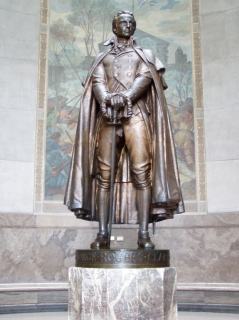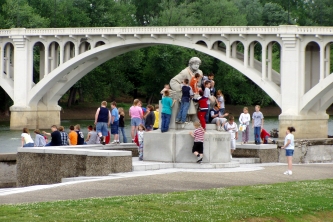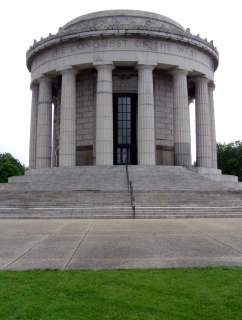Local Website
 WHAT IS IT?
WHAT IS IT?A classical Greek-style memorial that commemorates both the defeat of the British at Fort Sackville (Vincennes) in February 1779 and the life of Indian fighter and American pioneer, George Rogers Clark.
Please do not be confused. George Rogers Clark did not forge the Lewis & Clark Trail; that was his younger brother, William Clark.
BEAUTY (4/10)
The Memorial is a typical classical-style Memorial. Its granite exterior consists of sixteen columns that support circular roof. A larger than life bronze statue of George Rogers Clark sits in the building's center, underneath a glass skylight. The Indiana limestone walls are adorned with full color murals of Clark’s pioneer exploits.
HISTORICAL INTEREST (4/10)
George Rogers Clark has often been called a brilliant military strategist. After learning more about him and the Battle at Vincennes, we are not so sure. He was undoubtedly a hot-headed madman whose National Parks Service Site and federally endowed Memorial is more than a bit odd.
The Site often refers to The Battle of Fort Sackville as a Revolutionary War victory. Yes, the enemy was British, the year was 1779 but Clark was not fighting for the Continental Army, he was fighting for Patrick Henry and the territory of Virginia. Clark had left Fort Sackville unattended a year earlier choosing to set up his headquarters westward across the Illinois in Kaskaskia even though his British frontier nemesis Lt. Gov. Henry Hamilton was stationed in the east near Detroit. When the supposed Indian-ally Hamilton moved into the vacant Fort Sackville, Clark realized his tactical blunder and decided to regain the Fort.
Clark opted to attack Fort Sackville during February, when the British would be off-guard as well as short of soldiers and Indians. Somehow, Clark had forgotten that the Illinois prairies flood that month. He marched his troops 180 miles over 18 days. They were short of provisions because of miscommunication between Clark and the boat, The soldiers marched chest deep in freezing water, and, as far as we could tell by the maps, into the flooded areas instead of away from them.
Near frozen death, somehow the men arrived without casualties and besieged the Fort. Clark’s greatest talent must have been bluffing because he convinced Hamilton to surrender despite being outnumbered and at a geographical disadvantage. Clark’s victory changed little in the Revolutionary War. He merely gained control of the Ohio River from which he would launch attacks against frontier Indian tribes in the name of the Kentucky and Virginia territories.
 Clark never felt any dedication to the United States. In 1788 after his march of 1,200 Kentuckians against the Great Lakes Indians was abandoned he remarked, “no property or person is safe under a government so weak as that of the United States”. In 1793 Clark even accepted the position of French general with the goal of attacking the Spanish cities of New Orleans and St. Augustine. Both of his insurrections met strong rebuke from George Washington.
Clark never felt any dedication to the United States. In 1788 after his march of 1,200 Kentuckians against the Great Lakes Indians was abandoned he remarked, “no property or person is safe under a government so weak as that of the United States”. In 1793 Clark even accepted the position of French general with the goal of attacking the Spanish cities of New Orleans and St. Augustine. Both of his insurrections met strong rebuke from George Washington.As you can see, we were interested in the history of George Rogers Clark. We just have no idea why someone so openly hostile towards both the federal government and the very idea of the United States would have his own National Park Service Site.
CROWDS (4/10)
The large school groups at the Visitor Center must have been involved in a concerted plot to clog up every traffic artery inside the building. We believe they also had something to do with the man who snored loudly throughout the Site video. Once we went to the Memorial, everything was OK.
EASE OF USE/ACCESS (4/5)
Vincennes is not close to much at all. It is 50 north of Evansville and about 120 miles east of St. Louis, Mo. To get to the Historic Park, one must drive through a residential area and neighborhood streets. Even though there are signs, we couldn’t help doubt our directions. Are we going the right way?? Our fears were for naught. Right around the corner, there was the huge granite memorial, just like the signs said it would be.
The Visitors Center and memorial are accessible to anyone with a disability. The park which surrounds the Clark monument has several paved white paths outlining the area and leading the way to the memorial and the VC.
CONCESSIONS/BOOKSTORE (4/5)
Great selection. If William Henry Harrison and George Rogers Clark children’s books are on your list, you now know where to go.
COSTS (3/5)
$2 per adult, $4 per family, free with National Parks Pass.
RANGER/GUIDE TO TOURIST RATIO (3/5)
In the Visitor Center area, there were a few Rangers, but they all were giving lectures to school groups. We were lucky enough to have an unoccupied Ranger inside the Memorial itself to fill in the George Rogers Clark blanks.
 TOURS/CLASSES (4/10)
TOURS/CLASSES (4/10)We knew very little about Mr. Clark before the video presentation. Afterwards we were able to write four truncated paragraphs about the battle and harbor definitive emotions about the man.
The museum had different conclusions than ours about Clark.
The National Park Service provides headsets and a prerecorded tour of the Memorial’s interior. Michael despises those non-interactive Tour Guides so we skipped the canned lecture and asked the Ranger the 45 minutes worth of questions that the video had produced. He too found the Clark site to be historically odd. His candor on all park-related topics was refreshing.
FUN (4/10)
We really enjoyed talking with the Ranger. The size of the Memorial is impressive. That’s about it.
WOULD WE RECOMMEND? (2/10)
If it were not for the nicely manicured lawns and the nice Rangers it would be a wholehearted no. There are so many idealistic, honorable and noble characters in American history. George Rogers Clark is not one of them. His motives were selfish and not akin to those of the great men of his era.
TOTAL 36/80
www.usa-c2c.com
© 2004-06